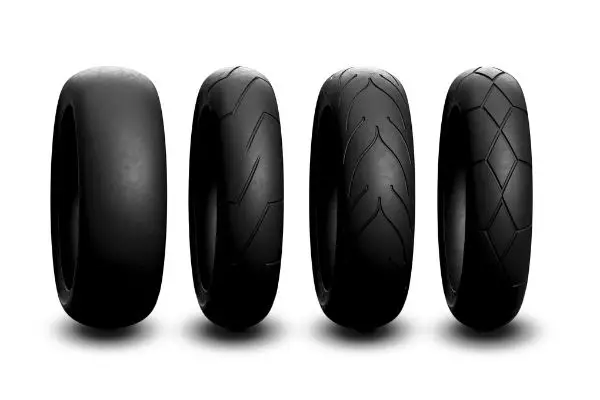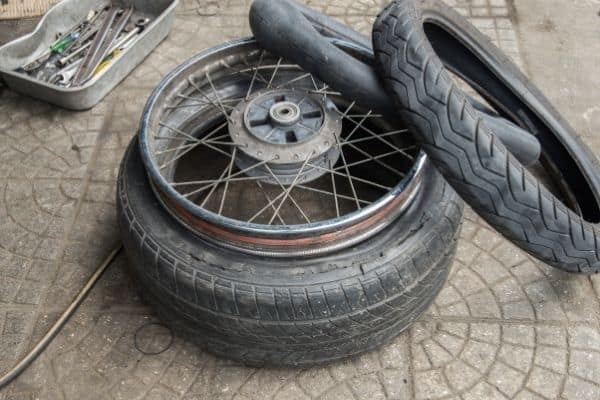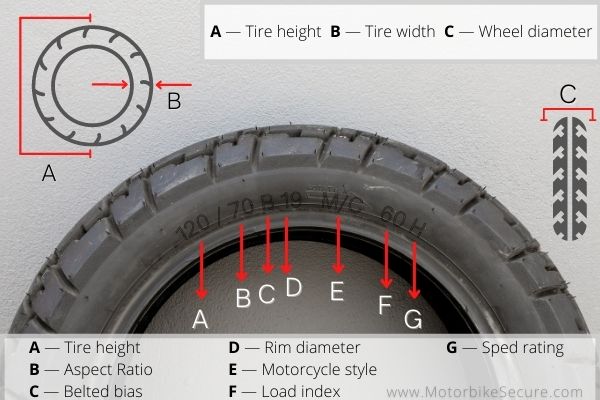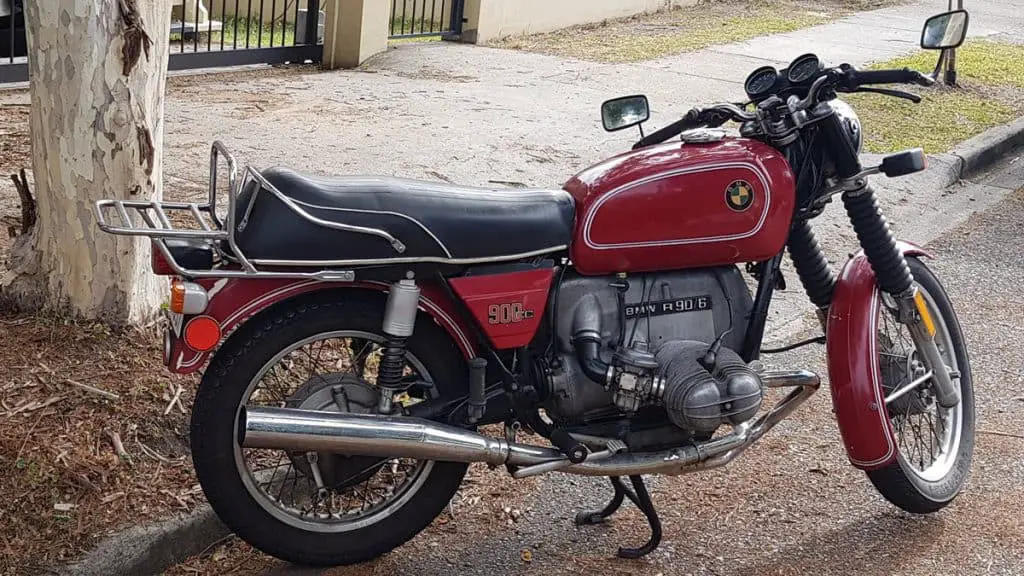Motorcycle Tire Measurements: Know What Your Tires Say
It goes without saying, choosing the right motorcycle tires is a must when you want to ride safely.
That means you need to know the exact type of tire your motorcycle needs.
But all those letters and numbers on the tire sidewalls, things can get confusing for rookies.
Well, if you’re feeling as lost as last year’s Easter egg amidst all this information, we’re here to help. This is our knockout guide on how to measure and read a motorcycle tire.
Let’s get started.
How to Read A Motorcycle Tire — The Basic Terminology
To understand motorcycle tire measurements, there are some terms that you need to get familiar with.
For starters, here’s a quick look at the main parts of a tire.
Tread
The tread is the hard part of the tire that forms the contact patch with the ground. There are a wide variety of tread patterns available for different surface types. Thicker and heavier treads are designed for off-roading. Directional tread patterns are effective for preventing aquaplaning and better stability at high speeds.

Treads are subdivided into other components, but we’ll skip them for now.
Carcass
The carcass is the main body that forms the structure of the tire. It’s located below the tread and made from cords that bond with the rubber. This provides the necessary strength for carrying the rated load.
💡 Even though the main component of a tire is rubber, there are a wide variety of compounds used to enhance tire properties. That’s one main reason for their high price tag.
In fact, some high-end tires are made from more than 200 types of raw materials
Bead
The bead is the edge of the tire that connects it to the wheel or the rim. Generally, it’s made from inextensible steel wires coated with rubber and fits snugly with the rim. It also creates a seal that holds the air within a tubeless tire.
Sidewall
The sidewall or the side surface connects the bead with the tread and is the most flexible part of a tire. They play an important role in load transfer and handling capability. The sidewall determines the height of the tire and also the aspect ratio.
Next, we look at the main technical terms that are important when it comes to tire sizing.

Width
The width of the tire is the straight-line distance between the two edges. You can also call it the minimum distance between the two sidewalls across the tread.
Aspect Ratio
The aspect ratio indicates the cross-sectional profile of the tire. The sidewall height is expressed as the proportion of the tire width. For example, an aspect ratio of 55 means the cross-sectional height is 55% of the width.
Speed Rating
This is the maximum speed suited for the tire. The speed rating allows you to select the right tire depending on the top speed of the motorcycle. The value of the tire will depend on the maximum load it can bear, and also on the inflation pressure.

Load Index
This is the maximum load the tire can carry at the rated speed. It’s related to the speed index. The figure is valid under the conditions of use specified by the tire manufacturer.
Rim Diameter
Rim diameter is the diameter of the wheel or the motorcycle wheel rim size on which the tire is mounted. Choosing a tire with the wrong rim size will affect the performance of the motorcycle.
Tire Construction
There are two main types of tires in the market: bias (or diagonal) tires and radial tires. You can also term it as the two main types of tire carcass design.
Belted tires are made from multiple layers of ply cords that create a criss-cross pattern. These are placed at an angle to the tread centerline. As a result, the crown and the sidewall have similar properties.
In radial tires, the ply cords are perpendicular to the tread centerline. On top of that, there’s a layer of crisscrossing steel belts. Here the tread and the sidewall have different properties.
Radial tires come with an “R” sign, whereas bias ply tires will have a “B” sign.
Most modern motorcycles have radial tires due to the higher level of comfort and enhanced high-speed stability that they offer. Besides, they have a better puncture and cut resistance as well.
Tire Type
Tires can come with an inner tube, or they can be tubeless. Tube-type tires aren’t airtight and the inner tube carries the air. Tubeless tires have an airtight fit with the rim.
Most modern bikes come with tubeless tires. But riders who like the traditional look with spokes on the wheels still choose tube tires
How to Read Motorcycle Tire Sizes?
Obviously, the biggest thing that you’ll notice on a tire is the manufacturer’s branding. Other than that, there can be specific symbols related to a tire type or a model name.
Now, there are two main types of nomenclature systems that are followed by tire manufacturers.

The Alphanumeric System
This is an old system that uses letters and numbers to mark the tie specifications. Even though the system was developed before the dawn of radial tires, it’s still used. Even some top brands like Harley-Davidson still follow the alphanumeric system.
Consider a tire with the alphanumeric code MT90B16.
Here’s what each of the terms stands for:
- M indicates a motorcycle tire
- T is the tire width code and can be determined from the charts provided by the manufacturer
- The aspect ratio of the tire is 90%
- B indicates tire structure, which is bias ply.
- The rim diameter is 16 inches.
The Metric System
As tire types got more complex, the metric system was developed for tire designation. The system includes numbers and letters as well.
For example, consider a tire with a code 205/60R15 91V
Here’s what the numbers and letters mean:
- 205 is the tire width indicated in millimeters
- 60 indicates the aspect ratio. This means the tire height is 60% of the tread width, i.e. 123 millimeters.
- R indicates the tire structure, which in this case is radial
- 15 is the rim diameter marked in inches
- 91 is the load index of the tire
- V stands for the speed rating
How to read a dirt bike tire size?
In dirt bikes, the system used is somewhat similar. You will find a number like 110/90-19 marked on a dirt bike tire. The numbers 110 and 90 indicate the tire width in millimeters and the aspect ratio respectively. The number 19 indicates the rim diameter in inches.
In addition, there can be other letters like 91V marked on the tire. 91 is the load rating and V indicates the speed rating.
Standard Inch System
Apart from these two systems, there’s also a Standard Inch measurement system used in some old tires found in antique motorcycles. This system is no longer in use for new motorcycle tires.
A tire specification in Standard Inch may look like 3.25H-19.
- 3.25 is the tire width in inches.
- H is the speed rating
- 19 is the rim diameter in inches
Here the aspect ratio is always 100% of the tire width. Also, these tires always have a bias ply construction.
Load Index Rating and the Speed index charts are available from various sources. Below are both charts as per the Motorcycle Industry Council guidelines:
LOAD INDEX RATING
| LI | lbs. | LI | lbs. | LI | lbs. |
|---|---|---|---|---|---|
| 33 | 254 | 51 | 430 | 69 | 716 |
| 34 | 260 | 52 | 441 | 70 | 739 |
| 35 | 267 | 53 | 454 | 71 | 761 |
| 36 | 276 | 54 | 467 | 72 | 783 |
| 37 | 282 | 55 | 481 | 73 | 805 |
| 38 | 291 | 56 | 494 | 74 | 827 |
| 39 | 300 | 57 | 507 | 75 | 853 |
| 40 | 309 | 58 | 520 | 76 | 882 |
| 41 | 320 | 59 | 536 | 77 | 908 |
| 42 | 331 | 60 | 551 | 78 | 937 |
| 43 | 342 | 61 | 567 | 79 | 963 |
| 44 | 353 | 62 | 584 | 80 | 992 |
| 45 | 364 | 63 | 600 | 81 | 1019 |
| 46 | 375 | 64 | 617 | 82 | 1047 |
| 47 | 386 | 65 | 639 | 83 | 1074 |
| 48 | 397 | 66 | 661 | 84 | 1102 |
| 49 | 408 | 67 | 677 | 85 | 1135 |
| 50 | 419 | 68 | 694 | 86 | 1168 |
SPEED INDEX CHART
| Speed Index | Maximum Speed |
|---|---|
| P | 93 mph |
| Q | 99 mph |
| R | 106 mph |
| S | 112 mph |
| T | 118 mph |
| U | 124 mph |
| H | 130 mph |
| V | 149 mph* |
| W | 168 mph** |
| (W) | more than 168 mph** |
💡 Tires rated for speeds higher than 186 mph have a “ZR” marking. In that case, the marking can look like – 275/40ZR17 93W.
Apart from that, every street-legal tire in the US comes with a Department of Transportation (DOT) serial number. This number begins with the words “DOT” and can be anywhere between 12 to 16 digits long.
(16 digits! Sounds like a piece of cake.)
Thankfully, you don’t need to crack the code of all these numbers. The last four digits of the code are extremely important as this tells you the date of the tire.
This will help you to determine how much life is left in the tire. Tires that are older than 10 years should be replaced.
If the last four digits of the DOT code are “4220”, it means that the tire was manufactured in the 42nd week of 2020.
There’s something else.
(Who put you up to this?)

Motorcycle tires also come with an arrow to indicate the direction of rotation. While mounting you need to make sure the arrow points in the right direction.
In addition, the tire can also have “front” or “rear” written on it. This will help you to mount it on the right wheel.
Note these two aspects are extremely important for ensuring the best ride quality and safety. Tires are designed to rotate in one direction only. Getting the direction of rotation of the tire wrong can be dangerous. Also, using a rear tire on the front, or vice versa can be a big mistake.
Most tires also have the air pressure that they are suited for marked on them. Usually, this is marked as “Maintain (X) PSI”.
Never inflate the tires beyond the recommended PSI specified by the manufacturer. At the same time, underinflated tires can generate excess heat, and affect gas mileage.
The pressure can vary depending on the ride conditions and the load you’re carrying. But always follow the manufacturer’s recommendations for those conditions.
How To Pick the Right Motorcycle Tires

Honestly, I felt as confused as a goat on astroturf after I learned about how to read a motorcycle tire size. (Affirmative.)
How do you pick the right tire by juggling all these numbers and letters?
The first aspect is to choose a tire that fits your needs. This means picking the right category of the tire from the four main families. These are the street, cruiser, dual-sport/ADV, and dirt.
The next step is choosing the best tire of the right size.
For that, the best way is to stick to the specifications of the stock tires that the motorcycle was tested with. Manufacturers recommend tires that work in balance with all the other components to deliver optimized performance.
As long as you stick to those specifications, there’s no need for any concern. You can always go for different tire brands though
Now, this doesn’t mean that veteran sportbike and dirt/dual-sport bike riders don’t experiment with tire sizes. Here are two ways many riders think of deviating from the specs:
- Upsizing by using a wider tire or wheel.
- Downsizing by using a narrower tire or wheel
This is one area where I’ll suggest you tread lightly. Here are the reasons:
- A bigger tire can rub with the other parts of the bike including the swing arms and sprockets. This may impact ride safety and cause the tire to wear at a faster rate.
- Changing the wheel size can affect the gearing ratios. This will in turn affect the top speed and the acceleration of the bike.
- While a wider tire will have a larger contact patch with the ground, it will have more rolling resistance too. This will impact the fuel mileage.
- Upsizing or downsizing the tires will change the distance covered per rotation of the wheel. This can affect the speedometer and the odometer readings.
- While a larger tire might give you more stability, you will need to put more effort into turning the handlebars. That will reduce the maneuverability of the bike.
Long story short, you have every right to experiment with tire sizes. But be aware of the risks involved.
Using a tire with non-OEM specifications can have dangerous consequences.
And one more thing…
(Thanks, but I’ll sit this one out.)
It’s best not to mix bias ply and radial tires. Always stick to the original type of tires that the manufacturer recommends.
Quite simply, these two tire types have different structures. So their ability to carry the load and handle the balancing forces also differ.
When you introduce a bias ply tire to a wheel designed for a rear tire, it can severely affect the balance and performance of the bike.
Frequently Asked Questions
What do the numbers on a motorcycle tire stand for?
The numbers on a motorcycle tire provide a wide range of information on the tire. These include the tire width, aspect ratio, rim diameter, tire construction type, load rating, and speed rating. In addition, the production date of the tire is also mentioned.
How do you read motorcycle wheels?
The necessary information about motorcycle wheels can be read from numbers molded on the sidewall of the tire.
Is a wider tire better on a motorcycle?
Wider tires on a motorcycle provide a larger contact patch and increase traction. However, the manufacturers select tires based on the engine capacity to ensure optimized performance.






